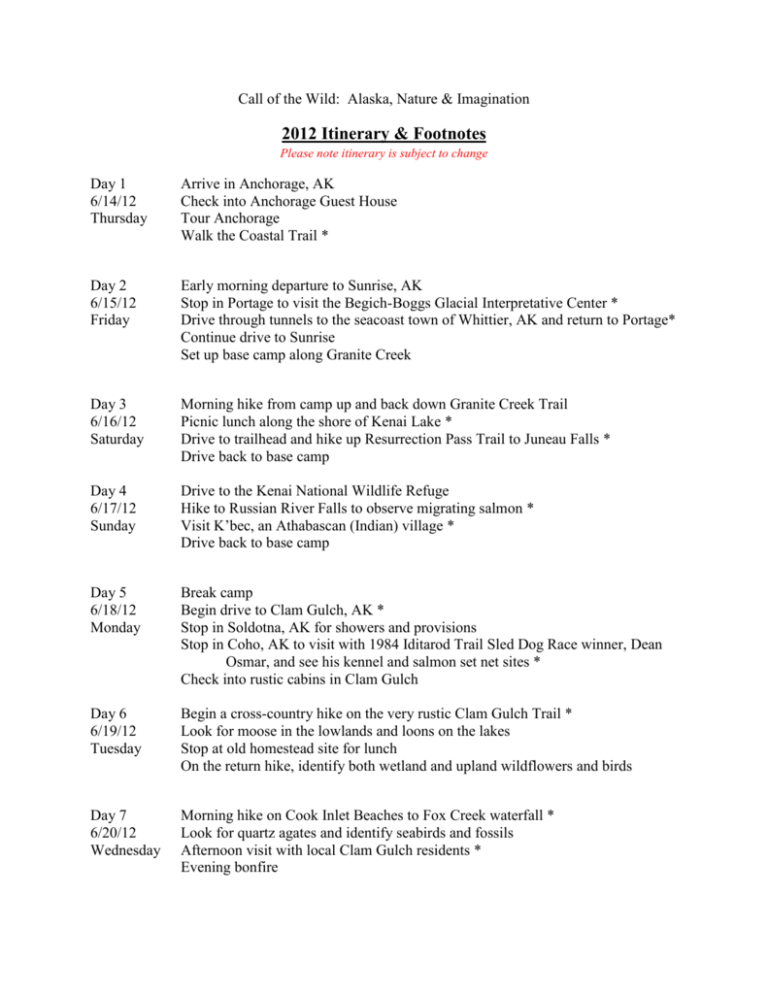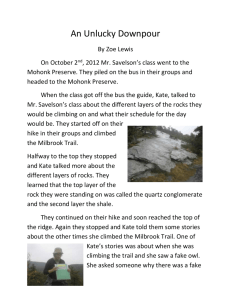2012 Itinerary & Footnotes
advertisement

Call of the Wild: Alaska, Nature & Imagination 2012 Itinerary & Footnotes Please note itinerary is subject to change Day 1 6/14/12 Thursday Arrive in Anchorage, AK Check into Anchorage Guest House Tour Anchorage Walk the Coastal Trail * Day 2 6/15/12 Friday Early morning departure to Sunrise, AK Stop in Portage to visit the Begich-Boggs Glacial Interpretative Center * Drive through tunnels to the seacoast town of Whittier, AK and return to Portage* Continue drive to Sunrise Set up base camp along Granite Creek Day 3 6/16/12 Saturday Morning hike from camp up and back down Granite Creek Trail Picnic lunch along the shore of Kenai Lake * Drive to trailhead and hike up Resurrection Pass Trail to Juneau Falls * Drive back to base camp Day 4 6/17/12 Sunday Drive to the Kenai National Wildlife Refuge Hike to Russian River Falls to observe migrating salmon * Visit K’bec, an Athabascan (Indian) village * Drive back to base camp Day 5 6/18/12 Monday Break camp Begin drive to Clam Gulch, AK * Stop in Soldotna, AK for showers and provisions Stop in Coho, AK to visit with 1984 Iditarod Trail Sled Dog Race winner, Dean Osmar, and see his kennel and salmon set net sites * Check into rustic cabins in Clam Gulch Day 6 6/19/12 Tuesday Begin a cross-country hike on the very rustic Clam Gulch Trail * Look for moose in the lowlands and loons on the lakes Stop at old homestead site for lunch On the return hike, identify both wetland and upland wildflowers and birds Day 7 6/20/12 Wednesday Morning hike on Cook Inlet Beaches to Fox Creek waterfall * Look for quartz agates and identify seabirds and fossils Afternoon visit with local Clam Gulch residents * Evening bonfire Day 8 6/21/12 Thursday Drive onto native lands via Wise Old Road * Hike off-road into the backcountry Observe the impact of global warming on northern boreal forests Look for evidence of both black and brown bears Day 9 6/22/12 Friday Begin drive to Homer, AK Visit Russian Orthodox Church in Ninilchik, AK * Search for eagles at lunch spot next to Deep Creek Visit Norman Lowell Art Gallery near Anchor Point, AK * Set up base camp at Seaside Farm near Homer, AK * Day 10 6/23/12 Saturday Morning beach walk after breakfast Visit to Alaska Islands & Ocean Visitor Center * Lunch in Homer Visit the Pratt Museum of Natural and Cultural History * Explore Homer Spit & Harbor * Day 11 6/24/12 Sunday Early breakfast Drive to end of Homer Spit & Check-in with Mako Water Taxi Water taxi ride across Kachemak Bay * Hike to Greywinck Glacier Lake & Halibut Lagoon * Return water taxi ride to Homer Farewell dinner on Homer Spit Day 12 6/25/12 Monday Early breakfast Pack for trip back to NC Take showers Begin drive back to Anchorage, AK Arrive in Anchorage in time for flight back to North Carolina * Footnotes Coastal Trail – The Tony Knowles Coastal Trail has both an urban and wild feel to it. It encircles the city with many side trails branching off to neighborhoods. The citizens of Anchorage like to get outside and enjoy what Alaska has to offer. People walk, bicycle and jog the trails 24 hours a day. Begich-Boggs Glacial Interpretative Center – Named after two congressmen who died in a plane crash in the area but were never found, the Center is a wonderful introduction to the indigenous people of the Kenai Peninsula and its plants, wildlife, geology and ecology. Right outside of the Center’s educational building is Portage Glacier and Lake. Whittier, AK is one of the few winter-time, ice-free ports in Alaska. Located on Prince William Sound, the very small community is hemmed in by the sea and the Chugach Mountain Range. Everyone in the town lives in one large high-rise building. The only road to Whittier is through one way tunnels that are shared with trains. Kenai Lake – A very large glacial lake that is turquoise in color due to the finely suspended silt created by glaciers grinding down rock. The finely suspended silt is called glacial flour. Resurrection Pass Trail – Over 60 miles in length, the Trail was created in the late 1890s as miners made their way from the seaport of Seward, AK into the interior of Alaska in their search for gold. Juneau Falls is an impressive waterfall that you can feel as the earth shakes long before you actually view the falls. Russian River Falls – The falls of the Russian River are very impressive, not for their size, but for the volume of water flowing over them and the thousands of migrating salmon swimming in, up and over them to their spawning lake nearby. K’bec – The Dena’ina Athabascan native people known as the Kenaitze have inhabited the Kenai Peninsula of Alaska for thousands of years. K’bec is their attempt to educate visitors to their traditions and culture through interpretative walks featuring archaeological sites and traditional plant use. Tribal interpretations highlight their knowledge and respect for the plants and animals that sustain them. Clam Gulch, AK – In the early 1950s, before there were any roads on the southern Kenai Peninsula, Per and Fran Osmar homesteaded an area of the western coast of Cook Inlet known as Clam Gulch. Named after the abundant razor clams that are as large as an adult hand, the area is best known for its productive salmon set net fishery. The population of Clam Gulch is around 180 residents. Iditarod Trail Sled Dog Race – Sled dog racing is to Alaskans what football is to the lower 48 states. In 1984, Dean Osmar, son of Per and Fran Osmar, lead the 1000+ mile race to Nome from start to finish and won it in record time. A visit to his home offers an opportunity to visit an existing kennel of sled dogs and an active salmon set net site. A former Elon graduate in History, Matt Steible, fishes the site with Dean. Clam Gulch Trail – In order to qualify to race in the Iditarod Trail Sled Dog Race, one has to qualify in a shorter race. In January of each year, the 200-mile Tustumena Sled Dog Race takes place over the rustic Clam Gulch Trail and serves to qualify those mushers who finish. From late April through early October, the Trail offers great cross-country hiking opportunities, if you are willing to get your feet wet. Cook Inlet Beaches – Cook Inlet is an extension of the North Pacific Ocean with tidal ranges of over 20 feet twice a day. The Inlet is named after Captain Cook who sailed into the inlet looking for the Northwest Passage. The rocky/sandy beaches extend over 50 miles from Clam Gulch to Homer, AK. Forty miles on the other side of Cook Inlet from Clam Gulch, the Alaska and Aleutian Mountain Ranges converge giving rise to Mt. Spur, Mt. Redoubt and Mt. Illiamna, all volcanoes over 10,000 feet in height. Clam Gulch residents – The residents of Clam Gulch represent a sampling of people who are passionate about living in Alaska. Although very different in professions, educational backgrounds, values and politics, they somehow don’t let their differences divide them. Alaska can be a very harsh place to live where people that are different still need each other to survive. Native lands via Wise Owl Road – Rather than set up Indian reservations in Alaska, the federal government established native corporations to generate revenue for its shareholders, the native people. The CIRI native corporation owns and manages a significant amount of land between Clam Gulch and the Harding Ice Field. A warming climate during the past two decades resulted in an outbreak of spruce bark beetle which killed thousands of acres of spruce trees. A network of logging roads provides access into the heart of the native lands. Russian Orthodox Church in Ninilchik, AK: -- Before Alaska was owned by the United States, Russia occupied it in to the 1800s. Russians enslaved the native people of the Kenai Peninsula and brought with them their customs and religion. A few Russian Orthodox Churches built in the late 1890s still exist on the Kenai Peninsula, one of which is in Ninilchik. Norman Lowell Art Gallery: -- Norman Lowell and his wife moved to their present location near Anchor Point, AK in the late 1940s where they homesteaded and Norman began painting landscapes. Still painting, the gallery represents his life work and is a wonderful representation of the culture and environment of the southern Kenai Peninsula. Both Norman and his wife are usually present in the gallery to answer visitors’ questions. Seaside Farm: -- Located on the north shore of Kachemak Bay is Seaside Farm which offers amazing views of the Bay, the Kenai Mountains, glaciers and the Harding Ice Field. A large pasture and outdoor kitchen and living area make for a wonderful base camp from which to explore Homer and the surrounding maritime environment. Alaska Islands & Oceans Visitor’s Center: -- The Alaska Islands & Ocean Visitor’s Center exists to educate visitors about the Alaska Maritime National Wildlife Refuge. There are more miles of coastline in Alaska than in all of the rest of the United States combined. The refuge seeks to protect the abundant and unique wildlife that exists on thousands of islands throughout the region. Few people have the time or money to visit most of the refuge, so the Center’s exhibits halls and wet labs were created to help people understand why the refuge is so important. Pratt Museum of Natural & Cultural History: -- The Pratt Museum of Natural & Cultural History is a small private museum dedicated to educating its visitors to history and natural resources of the area. It has excellent exhibits on geology, archeology, history and biology. Its exhibit on the Exxon-Valdez Oil Spill of 1989 has won many awards and is a must see. Homer Spit & Harbor: -- Homer Spit is a glacial moraine upon which a road was built. At the end of the road is a “working” harbor which protects boats and ships of all shapes, sizes and uses. There are literally hundreds of fishing vessels mixed in with pleasure craft. Along the road next to the harbor, many small businesses serve the visiting public with food and gifts to purchase. Homer and Whittier are a striking contract to each other. Kachemak Bay: -- Kachemak Bay is the second largest estuary in the world measured in terms of number of species and biomass of species. It is surrounded by the southern terminus of the Kenai Mountains and Harding Ice Field and the Caribou Hills making for a beautiful and memorable landscape/seascape. Greywinck Glacier Lake & Halibut Lagoon: -- A glacier is nothing more than a river of ice flowing downhill. In the case of Greywinck Glacier, it flows from the Harding Ice Field, the largest ice field in the world. Chunks of ice routinely fall off the face of the glacier forming floating icebergs in the lake. A hiking trail originating from the glacial lake leads over a mountain pass to Halibut Lagoon, an arm of Kachemak Bay.







